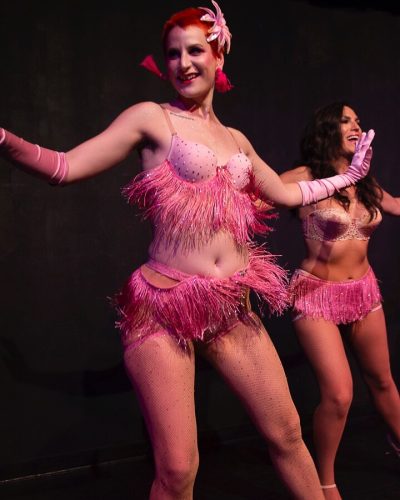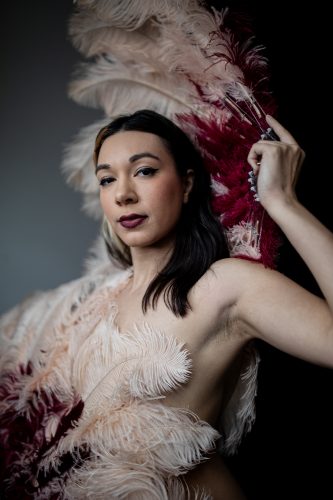
Learning to Look and Listen: Journeys in Burlesque and Photography
In the winter of 2016, just after the Trump election, I was invited to my first burlesque show by my friend Kitty Tornado, who was a new local performer at the time. I wasn’t exactly sure what I would see — but more importantly, I was definitely unsure how I would FEEL, confronted with sexuality that was both overt and celebratory when every morning I grimaced at my own reflection of enlarged pores, crooked teeth, and stretch marks. I don’t want to say that nudity and the female body made me uncomfortable, when held at a safe distance, but performing sexually or in the buff did seem like a scary phenomenon. Once performers took to the stage and began unraveling their individualized acts, I started to glean quite a bit of excitement from both the audience and the humans in the spotlight. One of the most compelling components of these performances was the music, which was blasting from multiple speakers, filling the dark room with everything from slow strippy showgirl jazz to aggressive rock and roll. A long time fan of blaring sounds to express inner sentiments, I was most enthused that burlesque seemed to mean a lot of autonomy and choice — choice of costume, choice of choreography, choice of music, choice of emotional tone. I immediately saw the art form as something special, something personal, and something that seemed to breathe exhilaration into a space, enlivening everyone in it. I was looking, listening, and fully engaged in these performers and their messages.

Greta-X (me) performing burlesque alongside Valencia Vice, 2019; photo by Sophie Page
Fast forward to the following year, when I was knee deep in taking classes at a studio that is now closed, learning how to perform burlesque. I can’t explain why I suddenly felt the impulse to extrovert myself and my insecure, vulnerable body with no prior background in dance, theater, or performance, but once seeing the show in 2016, I felt I needed to throw myself into what seemed like a magical and transformative world. “Only good will come of this,” I said. And until the first days of the pandemic, I was correct. I quickly became a member of a local ensemble and found myself juggling rehearsals and performances alongside my life as a barista and student (working 2 student jobs). It was chaotic always, but also fun always. I became embedded in a community, and even though we no longer perform together, the women I met through burlesque have become some of my closest confidants. Saturday nights were my favorite time of the week, filled with glitter and rhinestones, tassels and pasties, teases and shimmies and glove peels at every turn… so much to tantalize the senses.
Fast forward to my second Master’s degree at Columbia (the first was in Arts Management which I completed in spring of 2021). I returned to Columbia for an MFA in Photography in 2021 because I have been obsessed with images of glamorous and strange people — making and looking at them — since I was a child glued to the pages of my dad’s Rolling Stone magazines. Despite my life’s many changes, images have always resonated with and interested me. Throughout the Arts Management program, I kept making my own photographs. My undergraduate degree, which I used to regard as dusty and rusty and “essentially useless,” was also in photography (I, of course, no longer regard my undergraduate experience so glibly, but life as a barista/restaurant manager left me feeling regretful and sad about my education and talents once I moved to Chicago and was determined to make a living on my own… a difficult undertaking, no doubt). When the pandemic reared its ugly head, I took a pause from performing and began looking at the community through the lens of not only an artist but aspiring curator. I began photographing and interviewing my peers in burlesque and from there took on a new body of work which breathes life into all my interests.
Now we get to the truly complicated part. Last spring, before I started my MFA journey, I was looking closely at the work of a few photographers whose subject matter is burlesque, sex work, or both, like photographers Katharina Bosse and Kholood Eid, whose respective works have provided me a lot of inspiration in pursuing my own images. While burlesque and sex work are not new terrain for visual media, currently I have a specific vision that includes proudly displaying the eclectic, performative, sensual, and brave qualities of performers in my portraits. But, as is par for the course of being NEW to anything, I am filled with complex questions about how to visually describe the power of burlesque and forms of sex work in my pictures. I take a lot of notes as part of my practice so far, and these notes offer even more problems for me to resolve with my camera than clear answers. “They” say that grad school as an artist is filled with such complexities that never seem to cease — “they” are not wrong.

New Burlesque, 2002; photo by Katharina Bosse
From personally stepping foot on a stage and removing my clothing to now photographing those who do the same each week, I never stop learning to look and listen, the same way I did years ago when first experiencing the new-to-me art of striptease. Inspiration for art often comes from other art which all comes from life. As a performer, I am eager to improve upon my facial expressions while dancing, forming cohesive and tantalizing narratives, and engaging the audience authentically. As a photographer, I take portraits of these women… and while I study them closely before and after the actual making of the photograph, I also look elsewhere for clues as to how I might deepen the work, share their stories, and illuminate others about folks who utilize sexuality and gaze to not only earn a living but feed their creative spirit. Looking around you is good, but looking elsewhere and beyond is truly essential. I look at my work — and I look at others’ work, and do as my elementary school teachers advised and actively listen. No, I don’t always agree with the vocal reception of these photographs — but I do consider outside perspectives essential in helping me grow, in putting my subjects back on center stage.

The Maine Attraction at Duane Park in Manhattan, 2021; photo by Kholood Eid for The New York Times
I never thought I would wind up a burlesque performer, much less in grad school making images about other performers, but I have found myself in this unique and privileged position of creating art about something meaningful to my own life. I guess when I first conceived of going back to school many years ago (I wasn’t ready when I first started looking), I never realized that photographs were so complex and layered and that my position as the photographer was paramount to the way the images would be received. I was and still am obsessed with simply beautiful photographs, but I now know that my own work needs to exist BEYOND beauty and the mere aesthetic. In a world of perpetual images, mine still need a voice and a place to go. While I could be dismayed by this reality, I’m actually excited in the potential of their newness, in the promise of their undeveloped state. So, be patient with the process. Artist visits, faculty input, and student critique vitally shape this visual journey of grad school. Giving others advice is the same as giving it to myself: continue to look, to listen, and to feel secure that newness and confusion are what make art, and you, grow with vitality.

Ramona Romance, 2021; photo by Erica McKeehen
